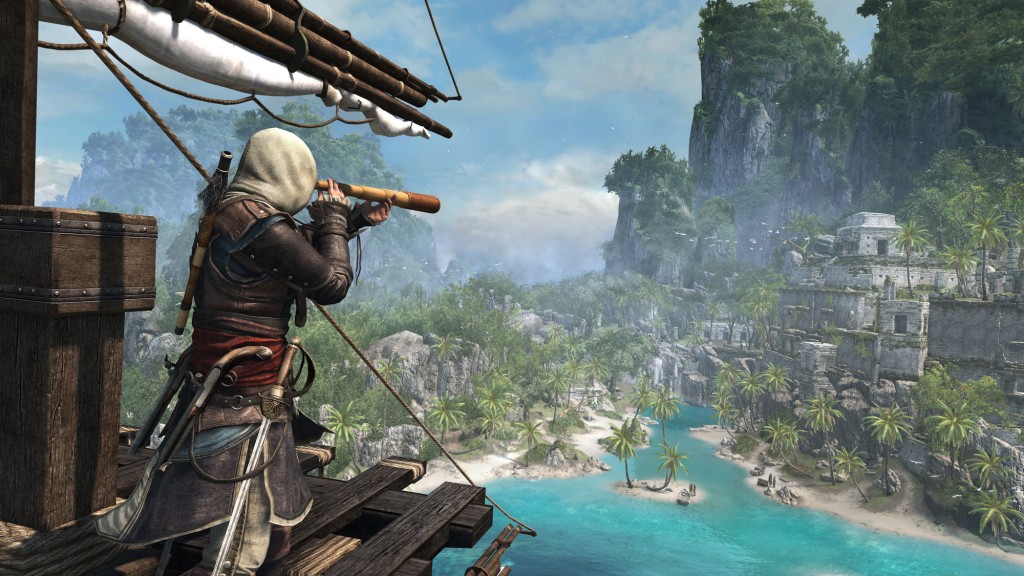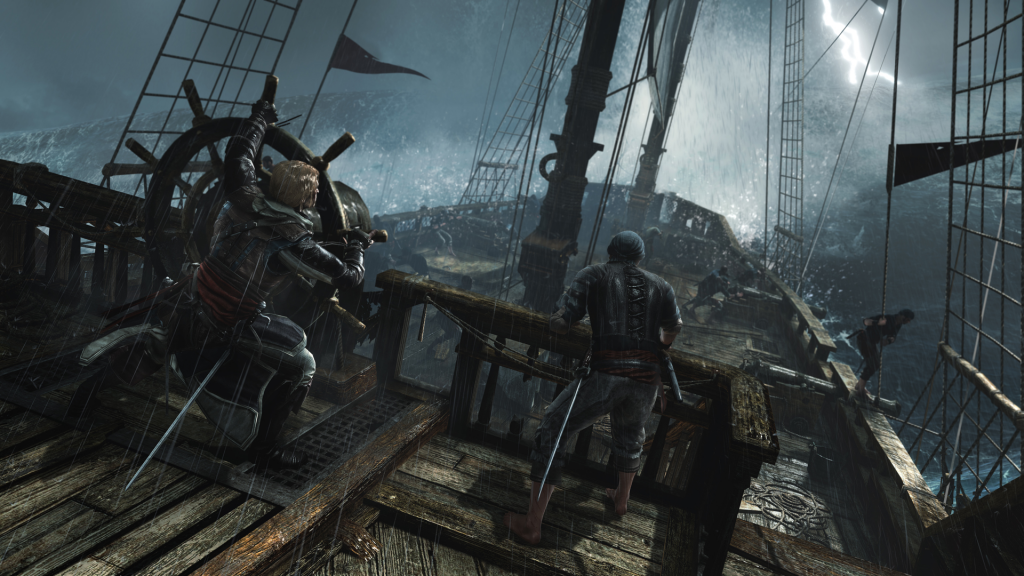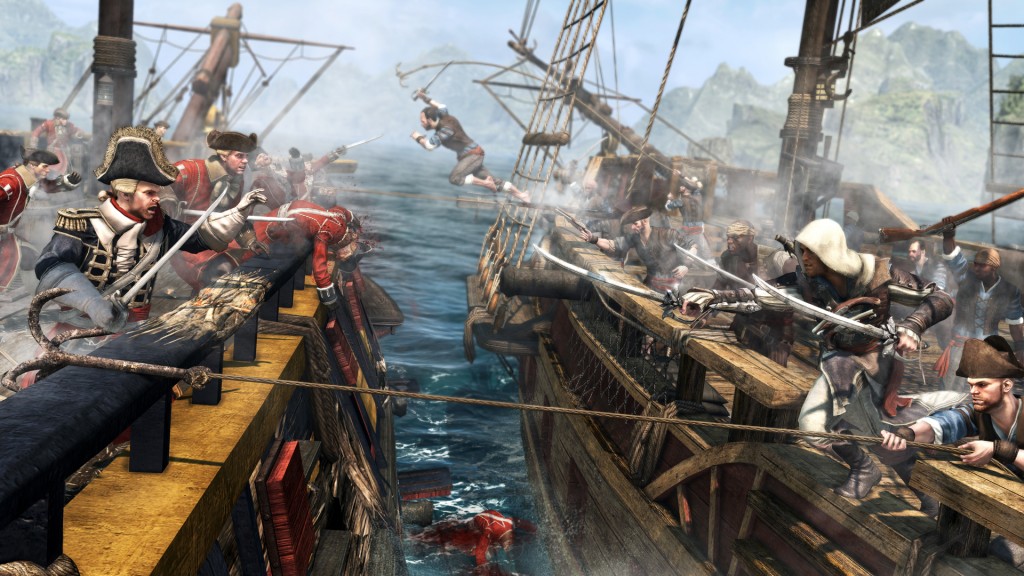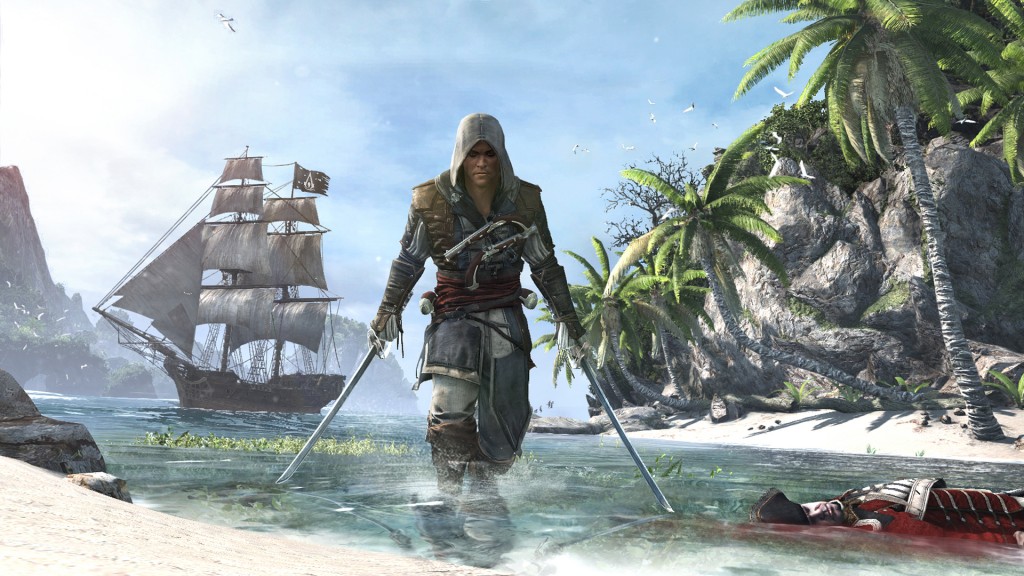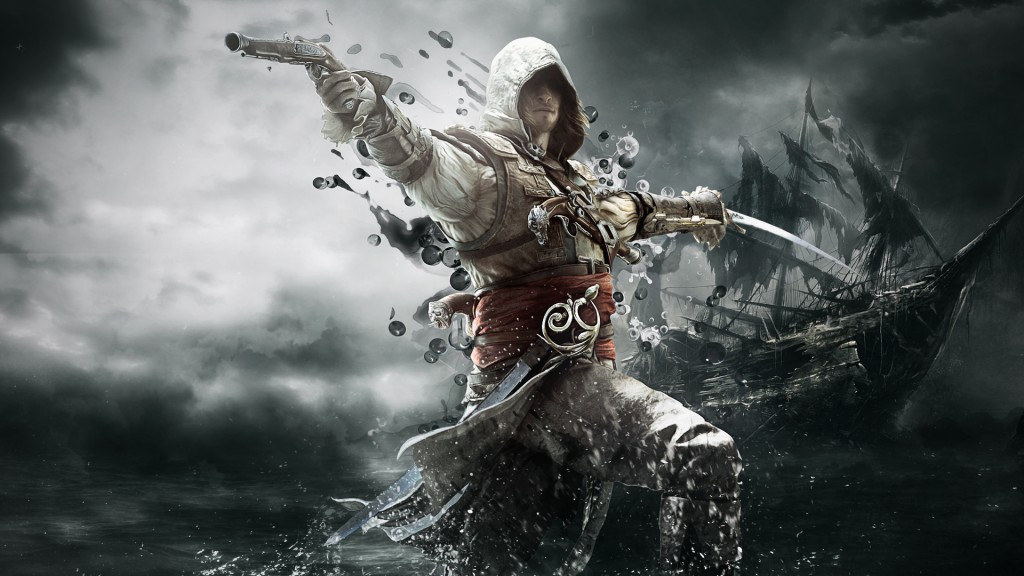 I didn’t much care for pirates before playing the latest Assassin’s Creed. Seafaring and swashbuckling, plundering and raiding were all concepts alien to me, as well as being experiences still relatively untapped by games. It’s only now, after playing Black Flag, that I realise the joys of pirate life and what I’ve been missing out on all this time. Like the previous games in the series, Black Flag takes a fairly unique, loosely historical setting – in this case, the Caribbean during the golden age of piracy – and realises it as a beautifully open 3 dimensional world that you can freely traverse and explore.
I didn’t much care for pirates before playing the latest Assassin’s Creed. Seafaring and swashbuckling, plundering and raiding were all concepts alien to me, as well as being experiences still relatively untapped by games. It’s only now, after playing Black Flag, that I realise the joys of pirate life and what I’ve been missing out on all this time. Like the previous games in the series, Black Flag takes a fairly unique, loosely historical setting – in this case, the Caribbean during the golden age of piracy – and realises it as a beautifully open 3 dimensional world that you can freely traverse and explore.
In this romantic pirate fantasy, you play as Edward Kenway, a young buccaneer from Swansea with dreams of getting rich. I found the quick-witted Welshman instantly likeable, which meant forging through the main narrative arc was easier than in previous Assassin’s Creeds. Dan Brown-esque sci-fi still punctuates the story, and are as jarring and needlessly frustrating as ever, although comparably brief. Much has already been made of the intrusion of the Animus – a virtual reality machine that creates worlds from ancestral memories stored in genes. However, it needs to be reiterated that these elements continue to tar what could otherwise be simply a sophisticated and interesting piece of historical fiction. On the other hand, if a few bits of shoddy, immersion-breaking sci-fi is what it takes for a big developer to commit resources to creating a fantastic historically-based setting, then I suppose we’ll have to make do.
For better or worse, Black Flag retains most of the old Assassin’s elements. The game allows the players to climb up most surfaces, clamber over rock-faces and up ship masts, sea cliffs and crooked palm trees. This rapid predator-like freedom of movement has always been one of the series’ great positives. It allows you to get a sense for the vast scale of the world, as well as making the environment seem more tangible. You can jump from one tree to the next in a thick jungle canopy, or just appreciate another glorious vista as you hang precariously from the great stone walls of one of several giant naval fortresses.
Along with the climbing, comes the combat, which whilst having a similar flow and grace as the movement, is outmoded when put side by side with many other action games. Whilst the movement in Assassin’s is cutting edge, the combat feels dated. Slashing cutlasses and volleys of flintlock fire look great, the simple counter-attack system allows the player to dance back and forth between a dozen enemies, gutting bellies and cutting throats, before diving backwards to unleash a flash of leaden pellets in a great puff of smoke – yet it’s all a thin spectacle. The combat is mainly cosmetic reassurance to ground you in the adventure, but is overall a poor example of action gameplay. Skin deep, it’s unchallenging and repetitive, and whilst it works to create a few spectacular set pieces – kicking someone overboard from the crow’s nest, clearing an entire ship worth of enemies single handily – eventually you’ll be watching the same few animations of Kenway slicing and dicing, over and over again. If you’ve played the previous Assassin’s games, you’ll be thoroughly sick of all this by now, and the system often works against a whole segment of the game’s economy and upgrade system. Character progression is diminished by the fact that even those with the remotest sense of timing will be able cut through an infinite swarm of enemies from the get go.
The scale and beauty of the Caribbean is Black Flag’s greatest strength. You can travel all the way from Nassau to Kingston Jamaica, or sail from Havana to Tortuga. The world is truly vast and the attention to detail is staggering. It all looks visually phenomenal too, and all of these attributes are enhanced through the full inclusion of ships and seafaring. The ocean in Black Flag is as important as the many islands, and the mechanics it introduces here in many ways surpass the different land-based excursions – the climbing, the parkour, the swordfights… and definitely the stealth, of which the less said about the better. Kenway attains a ship, the Jackdaw, and a crew early on in the game, and it is at this point that Black Flag opens up to become a great pirate simulator. Whilst many of the mechanics are simplified, and the economy and your ship crew scream for some added depth, the game really nails the feeling and fantasy of a great age of piracy. The seas around the Caribbean are free for you to navigate, and you can unboard your ship at almost any point, diving into the sea and swimming ashore to explore the many secret coves and desert islands. There is treasure to be found, and a dozen forms of collectibles as well. Most of these I found to be valueless and arbitrary, save for the precious sea shanties that your pirate crew bellow into the wind as you shuttle across the deep. There’s a powerful presence to Black Flag’s high seas, there’s a joy to the sailing, to bobbing in the calm tides as you peer through your spyglass in search of a target to raid, or in taming the 50 foot waves during one of the wild tropical storms which appear occasionally.
A full moon lights the night sky brilliantly. The sea is calm for the moment, and you’ve just finished eyeing precious cargo held aboard a convoy of ships, which you are now making a beeline towards. Previous raids have allowed you to upgrade the Jackdaw, whose ram you will now introduce to the vulnerable rump of a British frigate. Your armoured bow hits the back of the frigate like a giant spear, sending wooden shards everywhere. The rest of the convoy begins to take offensive manoeuvres, but due to the element of surprise you’re able to get the first few broadsides off. Smoke from the gunpowder fills the screen, and more wooden fragments fly. With the fight all but already won, you position yourself in order to let loose a final barrage of your heavy shot, but instead catch a glimpse of more ships on the horizon. As you finish off one frigate, you can make out the flags of the oncoming ships, their Union Jacks crumpling gently in the breeze. You also suddenly now notice the distinct red sails of a bounty hunter closing in on your rear. The fight complicated, you decide to deal with the hunter first. As it closes in on you, you begin to drop fire barrels from the aft of the ship, detonating them with your swivel cannons prematurely in order to cause maximum damage to the hunter bearing down on you. As more British frigates join the battle, you let loose the broadside cannons at will. The Jackdaw’s swivel cannons fire madly, and cannonballs from both sides fill the air. During the great struggle the sky begins to darken, a storm enters. Now as well as black powder and whizzing iron balls, chaotic waterspouts ravage the decks of ships. Rogue waves force you to brace the Jackdaw as you confront the giant swells of tide head on. You can take cover behind them, brief shelter from the continual torrents of ship fire, but you’re now more determined than ever to finish the fight. With the storm beginning to pass, you plough ahead, the few remaining ships appear as if in full retreat. You let your forward-facing chase guns blaze, their chained shots catching the sails of the retreating ships, briefly holding them in place for you to deliver the final blow. Cruising through the debris, you can loot what little you can from the sunken foes, but the main prize is aboard the original frigates, which, with their sails now riddled with holes and hotly ablaze, are just barely afloat.
When boarding ships, your crew can be seen using ropes and grappling hooks to bring the Jackdaw up close hull to hull. You can leave the wheel of your ship, zipping up to the mast before swinging across like Jack Sparrow to engage enemy sailors in some good old fashioned swashbuckling. It is in moments like these that you can see why, despite its flaws, the sword-fighting is aesthetically functional, although still quite a distance behind the epic naval engagements that possess both tactical flair and a challenge for much of the game. What’s most impressive is the continuity of the world – between the ship’s wheel and the on-deck squabbles, between sailing, swimming ashore and running across a sandy beach. The freedom Black Flag offers the player is a welcome surprise and completely liberating. As an example, early on in the game I came across one of the strongest ship types – a humungous Man O’ War whose huge broadsides and mortar fire decimated my ship in a head-to-head battle. However, not only would it be possible to close in on the anchored ship quickly and attempt to defeat it with your superior manoeuvrability, but you are able to outwit and bypass this naval scenario all together.
A stationary Man O’ War sits bobbing outside a small coastal town. It becomes immediately hostile towards you as you sail closer, so you decided to anchor the Jackdaw around the bay and out of the way, shaded by some cliff-face. You leave the wheel of your ship altogether, diving into the drink you spend a good few minutes wrestling with the waves in order to swim right up against the great Spanish galleon. You clamber up the side of the ship, being careful to avoid the cannons in case they suddenly fire – which they do on the Legendary ships – and then creep aboard. The galleon is bustling with musket-wielding soldiers, and although for a short while you’re able to pick them off one by one, soon the jig is up and the whole crew converges on you. After a long conflict, you stand victorious on the deck of the floating beast, a pile of bodies surrounding you. Feeling like you’ve accomplished the impossible, you now swim back around the bay to your own ship, which you then sail gently into town, looting the hollowed Man O’ War as you pass, with a smug look on your face all the while no doubt.
The set missions, repetitive and often stale, like the undercooked and often frustrating stealth segments and sword-fighting mechanics often make for poor action, but Black Flag is really a game about adventuring, and it sustains this feeling throughout. Beyond this, it is a great pirate game. The game gives you the room and freedom to form your own adventures and escapades, treasure hunts on desert islands, great raids on the British and Spanish costal fortresses or colonial plantations scattered around the Caribbean. The contracts and assassinations that were core to the previous games in the series are now secondary, and the set narrative is always stronger when sailing the high seas with your pal Blackbeard than when dealing with the assassins and templars or creeping about some linear alien observatory. Black Flag successfully frees itself from the tired Assassin’s formula. The shallow melee combat and exaggerated conspiratorial plot are all still here, but Black Flag also offers you the option of a pirate life; you get into a bar fight after some gambling goes badly, pissed on rum, you scuffle with some red coats in town, and then when you’re done you leave port and take to the seas alongside your crew in search of your next adventure – one of your own choosing. Mystical observatories and ancient relics long forgotten, your merry crew once again begin to sing “What Shall We Do With the Drunken Sailor”, and you can’t help but whistle along.

